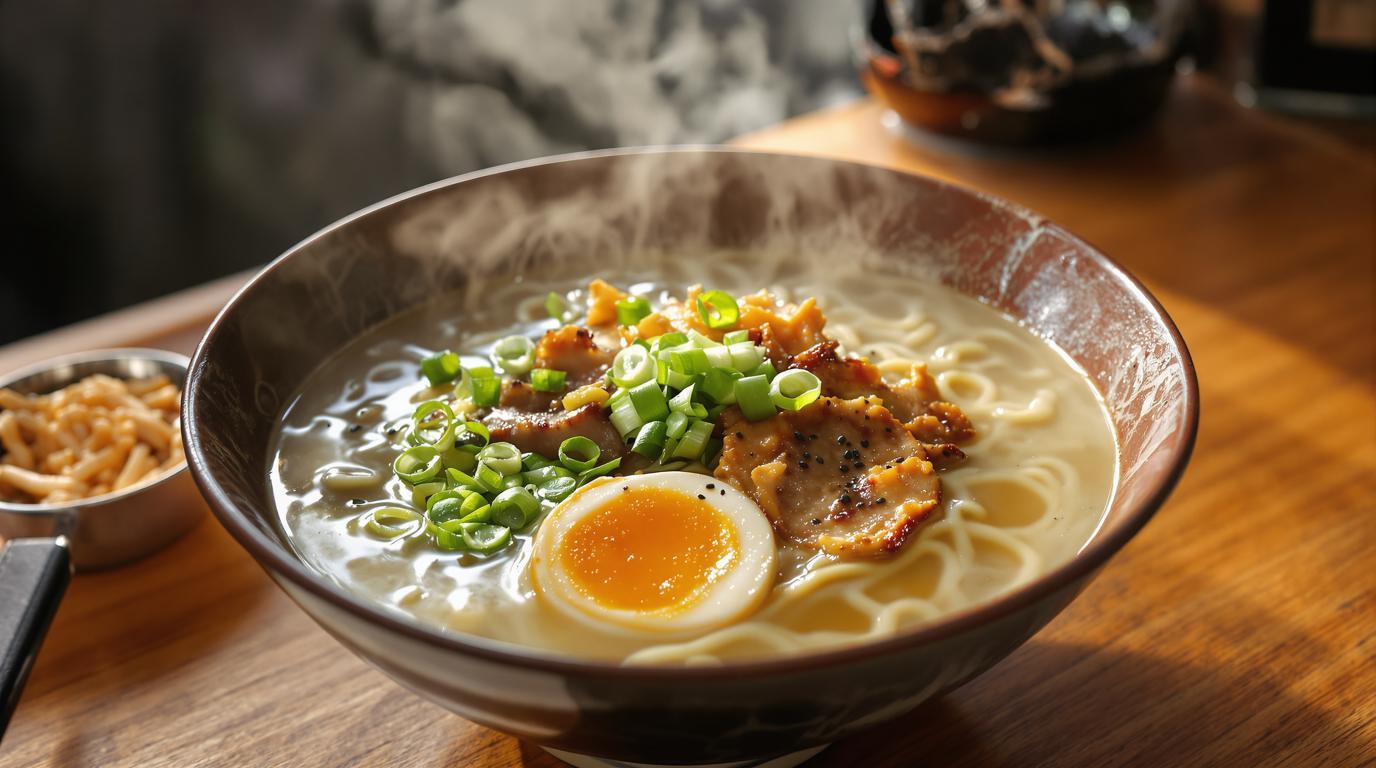There’s something deeply meditative about the 24-hour ritual of crafting tonkotsu ramen. When I first apprenticed in Fukuoka, my mentor Chef Yamamoto would say, “The broth doesn’t just extract flavor from bones—it extracts patience from the chef.” This milky, collagen-rich elixir transforms humble pork bones into liquid gold through nothing more than time, heat, and attention. The result is perhaps Japan’s most comforting bowl—intensely savory yet clean, with a silky mouthfeel that simply can’t be rushed. Let me guide you through this labor of love that has become my Sunday tradition.
The Art of Tonkotsu: Bone Broth Perfection 🍜
Tonkotsu ramen originated in Kurume, on Japan’s southern island of Kyushu, where resourceful chefs transformed butchers’ scraps into something magical. Unlike lighter Tokyo-style broths, tonkotsu extracts every bit of goodness from pork bones through extended simmering. The resulting milky-white broth is rich in gelatin, with a silky texture that coats each noodle perfectly.
I still remember my grandmother’s advice: “The bones tell you when they’re ready to share their secrets.” In professional kitchens, we know the broth is perfect when it cools to a wobbly, jelly-like consistency—proof that we’ve extracted maximum collagen.
Essential Ingredients 🧾
For authentic tonkotsu broth (makes 2 liters, serves 4-6):
- 2.5 pounds (1.25kg) pork backbones and trotters, split
- 2 chicken backs (about 1 pound/450g)
- 1 large onion, halved
- 1 head of garlic, halved crosswise
- 2 ounces (50g) kombu (dried kelp)
- 5 quarts (5L) filtered water
For the tare (seasoning base):
- ½ cup (120ml) soy sauce
- 2 tablespoons mirin
- 1 tablespoon sake
- ½ teaspoon sea salt
Chef’s Note: Can’t find kombu? Wakame seaweed offers a similar oceanic depth, though with less glutamic acid. Avoid substituting beef bones—their flavor is too assertive and will overpower the delicate pork notes we’re cultivating.
The 24-Hour Method 📝
- Prepare the bones (day before cooking): Soak bones in cold water for 6 hours, changing water twice. This removes blood and impurities that would cloud your broth.
- Roast for depth: Drain bones, pat dry, and roast at 425°F (220°C) for 40 minutes, turning halfway. This caramelization creates the foundation for a rich, complex broth.
- Initial extraction (first 4 hours): Place roasted bones, kombu, onion, and garlic in a large stockpot with 5 quarts of cold water. Bring to a rolling boil, then reduce to active simmer. Skim diligently for the first hour—these impurities are what create bitter, cloudy broth.
- Long extraction (next 20 hours): Reduce to barely a simmer (around 175°F/80°C)—the surface should show gentle movement, not bubbling. Add chicken bones after 8 hours. Maintain water level by adding hot water as needed.
- Finish the broth: After 24 hours, strain through fine mesh, then again through cheesecloth. You should have about 2 liters of milky, concentrated broth. Season with tare to taste.
Chef’s Secret Techniques 🤫
The difference between good and transcendent tonkotsu comes down to technique. First, never let your broth reach a full boil during the long extraction—this emulsifies fat differently and creates unpleasant cloudiness rather than the desired creamy opacity. Second, the “magic window” for adding chicken bones is around the 8-hour mark; this balances the porcine intensity with poultry’s subtle sweetness.
For a professional finishing touch, prepare aroma oil: render 1 cup of trimmed pork fat with 6 minced garlic cloves until golden. This flavored oil creates the signature glossy “eye” atop your finished bowl.
Serving Perfection 🍽️
A proper tonkotsu bowl is an exercise in balance and contrast. Cook fresh ramen noodles (preferably thin, straight variety) separately in boiling water for exactly 2 minutes. Drain thoroughly—water dilutes your precious broth!
In each preheated bowl, add 1-2 tablespoons of tare, followed by 1½ cups hot broth. Add noodles and arrange toppings artfully: thinly sliced chashu pork, halved soy-marinated eggs, sliced green onions, and a sprinkle of toasted sesame seeds.
For an unexpected but delightful summer twist, try a chilled version with additional citrus notes. And if you’re feeling experimental, my recent explorations with banana peel flour create an interesting dimension when incorporated into homemade noodles.
This process demands time, but that’s precisely what makes it special. In our instant gratification world, foods that require patience connect us to culinary traditions that span generations. Your first spoonful of homemade tonkotsu—with its velvety, complex character—will convince you that some things simply cannot be rushed. The depth of flavor you’ve created is your reward for honoring this ancient technique. Now slurp with abandon—in Japan, it’s the highest compliment to the chef!
